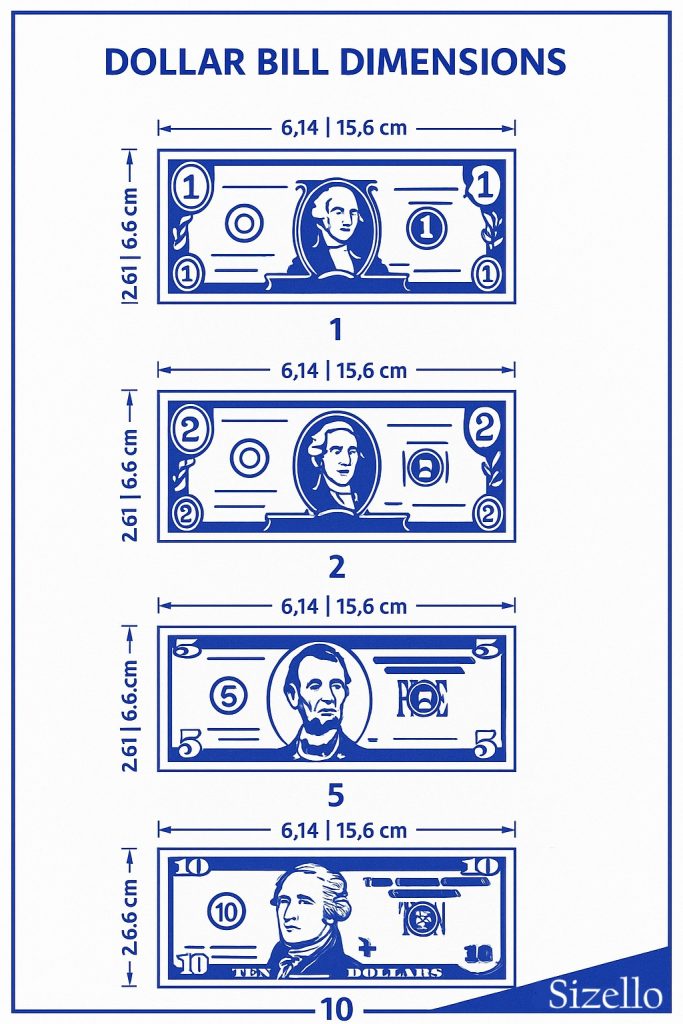Ever slipped a crisp bill into your wallet and wondered why it fits so perfectly? Or why a vending machine accepts a ten-dollar note just as readily as a one? That has everything to do with one unsung design element: the dimensions of the U.S. dollar bill. At first glance, it’s just paper with numbers and faces. But behind every note is a careful standardization that ties into history, design, and function. So let’s look at the actual size of a dollar bill and why it matters more than you might think.

Current Dimensions of U.S. Dollar Bills
All U.S. paper currency—a $1, $5, $10, $20, $50, or $100 bill—shares the exact dimensions. Each bill measures 6.14 inches long and 2.61 inches tall. The thickness? A rather unimpressive 0.0043 inches. Doesn’t sound like much, right? But that uniformity is crucial.
These dimensions have remained consistent for decades. Whether you’re pulling a crumpled dollar from your back pocket or withdrawing a fresh stack from the bank, you’re handling a note that was designed to slide effortlessly into wallets, stack neatly in cash registers, and work seamlessly with ATMs, currency counters, and vending machines.
Historical Changes in Dollar Bill Size
Here’s some fun trivia: U.S. bills weren’t always this size. Before 1929, paper currency was significantly larger. Known as “large-size notes,” these older bills measured about 7.375 inches by 3.125 inches. Holding one feels more like having a brochure than money.
In 1929, the Bureau of Engraving and Printing gave the dollar a wardrobe change. They standardized the size to what we know today. Why? To save money on printing and materials, of course. The new size reduced costs and made the currency easier to handle and store. It also laid the groundwork for consistency across denominations, which turned out to be a wise move as the economy and banking systems evolved.
Why All Denominations Share the Same Size
You might wonder why a $1 and a $100 bill look identical in size. Wouldn’t it be easier to distinguish value by making them different sizes? Some countries do that, but the U.S. stuck with the exact dimensions for several practical reasons.
First, it simplifies the design and production process. All bills can be printed using the same equipment. That means fewer adjustments and fewer chances for error. Second, it standardizes cash handling for machines and banks. From ATMs to currency sorters, uniform size equals easier processing.
There’s also the question of accessibility. The U.S. has faced criticism from advocacy groups because people who are blind or visually impaired can’t distinguish denominations by touch. For this reason, some countries, like Canada, use different sizes and tactile features. In response, the U.S. has started implementing features like raised printing and mobile app readers, but the size remains unchanged.
The Paper and Ink Used in Dollar Bills
Let’s get tactile. What exactly are these bills made of? If you’re thinking regular paper, think again.
U.S. currency is printed on a special blend of 75% cotton and 25% linen. That’s why bills feel different from your average printer paper. This material gives it durability—important considering how many hands a dollar passes through.
Then there’s the ink. It’s not just green and black; modern bills incorporate color-shifting inks, micro-printing, and embedded security threads. These features are essential for preventing counterfeiting, but they also need to work well with the unique paper blend. And yes, all that has to be accounted for within those compact 6.14 by 2.61 inches.
How the Size Impacts Wallets, Machines, and Handling
Size consistency isn’t just about aesthetics. That reliable rectangle affects almost every aspect of cash usage.
Wallet manufacturers, for one, design slots to fit standard U.S. bills. If dollar bills vary in size, wallets must be bulkier or designed to fit the largest denomination—not ideal for anyone who likes a slim profile.
Machines—from self-checkouts to arcade token dispensers—are programmed to read the physical properties of bills. Uniform size and paper thickness make this possible. Change the size and you’re talking software updates, recalibrations, and probably a lot of frustrated users.
Even for humans, handling cash would be trickier. Think about counting, sorting, or stacking bills quickly. Uniformity helps with speed and reduces confusion, especially in high-volume environments like retail or banking.
Dollar Bill Dimensions Compared to Other Currencies
Compared to the rest of the world, U.S. bills are a bit of an outlier. Many countries use different sizes for different denominations. For example, the Euro increases in size and color as value rises. Same goes for the British Pound and Japanese Yen.
Why? It’s partly visual, partly functional. Different sizes help reduce confusion and assist visually impaired users. Conversely, varying sizes complicate storage, machine calibration, and production. The U.S. took the opposite approach: prioritize uniformity and let design features carry the weight of differentiation.
Interestingly, U.S. bills are all the same size, so they’re often easier to manage in bulk. But they may also appear less “premium” compared to other nations’ vibrant, multi-sized notes. That said, few currencies can match the global recognition of a U.S. hundred-dollar bill.
Here’s a comparative table showing U.S. dollar bill dimensions compared to several major global currencies:
| Currency | Country/Region | Dimensions (mm) | Dimensions (inches) | Material Type |
|---|---|---|---|---|
| U.S. Dollar (USD) | United States | 155.96 × 66.29 | 6.14 × 2.61 | Cotton-linen blend |
| Euro (EUR) | Eurozone (19 countries) | Varies: 120–160 × 62–82 | Varies | Cotton paper |
| British Pound (GBP) | United Kingdom | 135 × 70 (new polymer) | 5.31 × 2.76 | Polymer |
| Canadian Dollar (CAD) | Canada | 152.4 × 69.85 | 6.00 × 2.75 | Polymer |
| Australian Dollar (AUD) | Australia | 137 × 65 (varies by denomination) | 5.39 × 2.56 | Polymer |
| Japanese Yen (JPY) | Japan | 150 × 76 | 5.91 × 2.99 | Washi (traditional paper) |
| Chinese Yuan (CNY) | China | 155 × 77 | 6.10 × 3.03 | Cotton paper |
| Swiss Franc (CHF) | Switzerland | 123 × 70 (20 CHF note) | 4.84 × 2.76 | Polymer |
| Indian Rupee (INR) | India | Varies: 120–147 × 63–66 | Varies | Cotton rag paper |
Conclusion
So next time you handle a dollar bill, take a moment. Behind that familiar rectangle is a blend of design, history, and practicality. Those seemingly simple dimensions influence everything from how you carry cash to how machines accept it. It’s not just a piece of paper—it’s a system built to work seamlessly in a fast-moving world. All packed into 6.14 by 2.61 inches.

Suzana explores how culture, geography, and tradition influence the sizes of everyday items—from clothing to furniture. With international research experience, he brings global perspective to Sizello’s content.


Leave a Reply